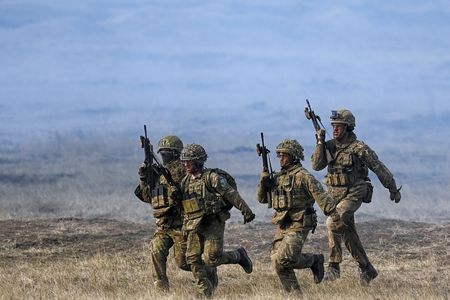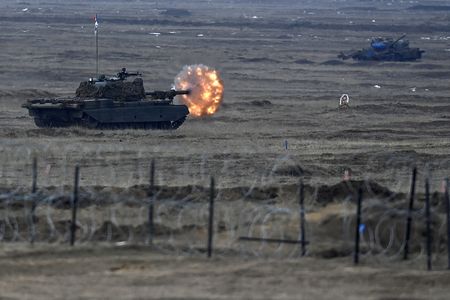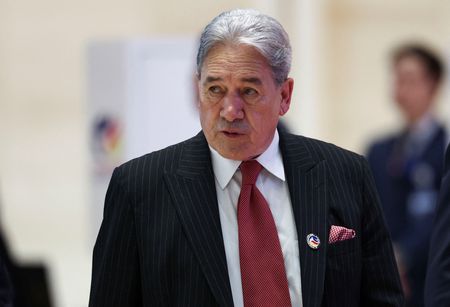By Luiza Ilie
BUCHAREST (Reuters) -The United States plans to cut the number of troops present on Europe’s eastern flank, including soldiers who were to be stationed at Romania’s Mihail Kogalniceanu air base, Romania’s defence ministry said on Wednesday.
The ministry said the decision was expected given changes in Washington’s priorities, and that roughly 1,000 U.S. troops would continue to be stationed in Romania. Between 1,000 and 1,200 U.S. troops rotated out a month ago and will not be replaced, it said in a statement.
Washington’s European allies have been told previously by the administration of President Donald Trump that they will need to take more responsibility for their own security as the United States focuses more on its own borders and on the Indo-Pacific region.
“The American decision is to stop the rotation in Europe of a brigade that had elements in several NATO countries,” the defence ministry said.
REPUBLICAN LAWMAKERS OPPOSE THE MOVE
The U.S. military said the decision not to replace departing American troops in Romania was not “an American withdrawal from Europe or a signal of lessened commitment to NATO”.
But in a rare move, the top U.S. Republican lawmakers on the Senate and House Armed Services Committees slammed the move.
“We strongly oppose the decision not to maintain the rotational U.S. brigade in Romania,” the joint statement said, adding that the lawmakers were seeking clarification from the Pentagon.
Defence Minister Ionut Mosteanu told a news conference that the brigade had troops in Romania, Bulgaria, Hungary and Slovakia.
He said Bucharest’s ties with Washington remained strong and that the permanent allied presence remained “considerable”, at around 3,500 NATO troops including U.S. soldiers.
“It is enough for our needs,” Mosteanu said. “The expectation of having entire foreign armies here to defend us is unrealistic. We will continue to invest in the Romanian army.”
He said Romania had received an advanced air defence system from Washington which would enhance the country’s ability to protect itself against drones breaching its airspace.
NATO SAYS ALLIANCE IN CLOSE CONTACT
The EU and NATO state shares a 650 km (400 mile) land border with Ukraine and has seen Russian drones breach its airspace more than 20 times over the last two years, as well as mines floating in the Black Sea across key trade and energy routes.
A NATO official said the alliance was in close contact about the deployment of its forces, adding that adjustments to U.S. deployments were not unusual.
Slovakia’s defence ministry said the decision not to replace the rotating brigade only affected Romania and that Slovakia’s defence was provided by its Spain-led multinational NATO brigade.
Italian Defence Minister Guido Crosetto told Sky that the process of the U.S. shifting its focus had started under President Barack Obama. “The U.S. is concerned about competition with China, and Europe must guarantee its own defence,” he said.
Despite worries on NATO’s eastern flank about the potential scaling back of the U.S. presence in the region, at a time when Russia continues to wage war in Ukraine, Trump said in September that Washington could increase its troop presence in Poland.
Polish Defence Minister Wladyslaw Kosiniak-Kamysz and Lithuanian presidential adviser Deividas Matulionis both said they had not received any information about a possible reduction of U.S. troops on their territory.
(Reporting by Luiza Ilie in Bucharest; Additional reporting by Alan Charlish in Warsaw, Andrew Gray and Lili Bayer in Brussels, Francesca Piscioneri in Rome; Andrius Sytas in Vilnius, Octav Ganea and George Calin in Bucharest; Idrees Ali and Phil Stewart in Washington. Editing by Alison Williams and David Holmes)












